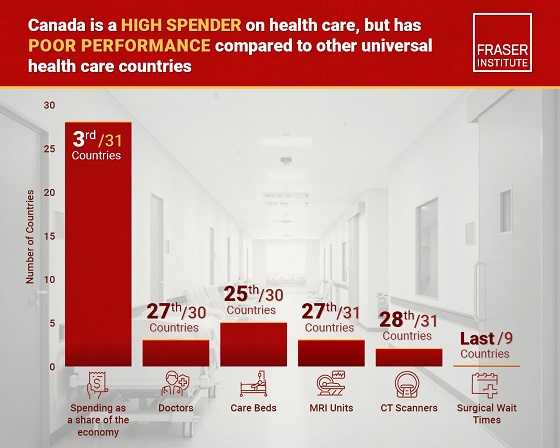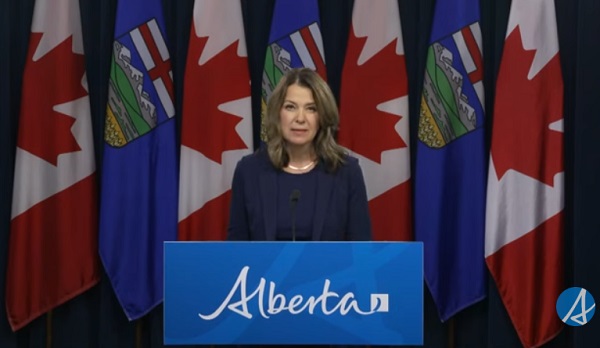Fraser Institute
Federal government cranked up spending up but Canadians are worse off

From the Fraser Institute
By Matthew Lau
“If spending money like water was the answer to our country’s problems,” Margaret Thatcher said in 1980, less than two years after the United Kingdom’s Winter of Discontent, “we would have no problems now. If ever a nation has spent, spent, spent, and spent again, ours has.” That a government cannot spend away the country’s problems is a clear lesson of history. The Trudeau government evidently has not learned this—it has spent, spent and spent more, and the country’s problems have gotten worse.
In 2014-15, before the Liberals took office, federal program spending was 12.8 per cent of GDP (the value of final goods and services produced in Canada). In 2023-24, it’s projected at 15.7 per cent. And relative to 2014-15, annual program spending is $89 billion higher than if it had tracked with overall economic growth.
As Thatcher would have predicted, this extra spending has not solved most problems. Consider health care. The Fraser Institute’s survey of health-care specialists found a median wait time of 27.7 weeks between referral from a general practitioner and receipt of treatment in 2023—a 51 per cent increase versus the 18.3 weeks in 2015. Relative to peer countries, Canada is a big health-care spender but with poor results, and is far below average on key metrics such as physicians and hospital beds per capita.
Another big spending area is climate change. The Liberals boast of pouring more than $120 billion into climate programs, but even with an annually increasing carbon tax and onerous regulation on top of that spending, the government is on track to miss its 2030 climate targets. Given the high cost of its climate policies relative to environmental benefits, that’s not a bad thing. Ottawa’s climate targets are wildly unrealistic, and achieving them would mean devastating the economy further.
Speaking of devasting the economy, when the Trudeau government spends, it claims it will support economic growth, increase affordability or otherwise deliver financial benefits. Eight years in, these benefits have not materialized. As of the third quarter of 2023, after five consecutive quarters of declining real GDP per capita, Canada’s cumulative growth in the past eight years is a paltry 1.6 per cent versus 14.7 per cent in the United States. One way to think about this gap: if Canada’s real GDP per-capita growth tracked with the U.S. since the Liberals took office, Canadian living standards would be about 12.8 per cent higher than they are today.
Finally, the Trudeau government has significantly ramped up child-care spending, but the effect of the national child-care program has been to severely distort and in many cases destroy the child-care sector by applying a discriminatory funding model that pushes child-care entrepreneurs out of the market and discourages private investment. The federal program is composed of separate agreements with the provinces, but with the child-care sector suffering crisis and widespread shortages from coast to coast, it’s reasonable to conclude Ottawa’s plan is fatally flawed.
Wherever you look, the pattern is the same—federal spending is up, but outcomes are worse. The government creates problems and does not solve them when it spends money like water. Margaret Thatcher well understood this fact. Justin Trudeau, unfortunately, evidently does not.
Author:
Business
Canada has fewer doctors, hospital beds, MRI machines—and longer wait times—than most other countries with universal health care

From the Fraser Institute
Despite a relatively high level of spending, Canada has significantly fewer doctors, hospital beds, MRI machines and CT scanners compared to other countries with universal health care, finds a new study released today by the Fraser Institute, an independent, non-partisan Canadian public policy think-tank.
“There’s a clear imbalance between the high cost of Canada’s health-care system and the actual care Canadians receive in return,” said Mackenzie Moir, senior policy
analyst at the Fraser Institute and author of Comparing Performance of Universal Health-Care Countries, 2025.
In 2023, the latest year of available comparable data, Canada spent more on health care (as a percentage of the economy/GDP, after adjusting for population age) than
most other high-income countries with universal health care (ranking 3rd out of 31 countries, which include the United Kingdom, Australia and the Netherlands).
And yet, Canada ranked 27th (of 30 countries) for the availability of doctors and 25th (of 30) for the availability of hospital beds.
In 2022, the latest year of diagnostic technology data, Canada ranked 27th (of 31 countries) for the availability of MRI machines and 28th (of 31) for CT scanners.
And in 2023, among the nine countries with universal health-care systems included in the Commonwealth Fund’s International Health Policy Survey, Canada ranked last for the percentage of patients able to make same- or next-day appointments when sick (22 per cent) and had the highest percentage of patients (58 per cent) who waited two months or more for non-emergency surgery. For comparison, the Netherlands had much higher rates of same- or next-day appointments (47 per cent) and much lower waits of two months or more for non-emergency surgery (20 per cent).
“To improve health care for Canadians, our policymakers should learn from other countries around the world with higher-performing universal health-care systems,”
said Nadeem Esmail, director of health policy at the Fraser Institute.
Comparing Performance of Universal Health Care Countries, 2025
- Of the 31 high-income universal health-care countries, Canada ranks among the highest spenders, but ranks poorly on both the availability of most resources and access to services.
- After adjustments for differences in the age of the population of these 31 countries, Canada ranked third highest for spending as a percentage of GDP in 2023 (the most recent year of comparable data).
- Across 13 indictors measured, the availability of medical resources and timely access to medical services in Canada was generally below that of the average OECD country.
- In 2023, Canada ranked 27th (of 30) for the relative availability of doctors and 25th (of 30) for hospital beds dedicated to physical care. In 2022, Canada ranked 27th (of 31) for the relative availability of Magnetic Resonance Im-aging (MRI) machines, and 28th (of 31) for CT scanners.
- Canada ranked last (or close to last) on three of four indicators of timeliness of care.
- Notably, among the nine countries for which comparable wait times measures are available, Canada ranked last for the percentage of patients reporting they were able to make a same- or next-day appointment when sick (22%).
- Canada also ranked eighth worst for the percentage of patients who waited more than one month to see a specialist (65%), and reported the highest percentage of patients (58%) who waited two months or more for non-emergency surgery.
- Clearly, there is an imbalance between what Canadians get in exchange for the money they spend on their health-care system.
Mackenzie Moir
Senior Policy Analyst, Fraser Institute
Alberta
Petition threatens independent school funding in Alberta

From the Fraser Institute
Recently, amid the backdrop of a teacher strike, an Alberta high school teacher began collecting signatures for a petition to end government funding of independent schools in the province. If she gets enough people to sign—10 per cent of the number of Albertans who voted in the last provincial election—Elections Alberta will consider launching a referendum about the issue.
In other words, the critical funding many Alberta families rely on for their children’s educational needs may be in jeopardy.
In Alberta, the provincial government partially funds independent schools and charter schools. The Alberta Teachers’ Association (ATA), whose members are currently on strike, opposes government funding of independent and charter schools.
But kids are not one-size-fits-all, and schools should reflect that reality, particularly in light of today’s increasing classroom complexity where different kids have different needs. Unlike government-run public schools, independent schools and charter schools have the flexibility to innovate and find creative ways to help students thrive.
And things aren’t going very well for all kids or teachers in government-run pubic school classrooms. According to the ATA, 93 per cent of teachers report encountering some form of aggression or violence at school, most often from students. Additionally, 85 per cent of unionized teachers face an increase in cognitive, social/emotional and behavioural issues in their classrooms. In 2020, one-quarter of students in Edmonton’s government-run public schools were just learning English, and immigration to Canada—and Alberta especially—has exploded since then. It’s not easy to teach a classroom of kids where a significant proportion do not speak English, many have learning disabilities or exceptional needs, and a few have severe behavioural problems.
Not surprisingly, demand for independent schools in Alberta is growing because many of these schools are designed for students with special needs, Autism, severe learning disabilities and ADHD. Some independent schools cater to students just learning English while others offer cultural focuses, expanded outdoor time, gifted learning and much more.
Which takes us back to the new petition—yet the latest attempt to defund independent schools in Alberta.
Wealthy families will always have school choice. But if the Alberta government wants low-income and middle-class kids to have the ability to access schools that fit them, too, it’s crucial to maintain—or better yet, increase—its support for independent and charter schools.
Consider a fictional Alberta family: the Millers. Their daughter, Lucy, is struggling at her local government-run public school. Her reading is below grade level and she’s being bullied. It’s affecting her self-esteem, her sleep and her overall wellbeing. The Millers pay their taxes. They don’t take vacations, they rent, and they haven’t upgraded their cars in many years. They can’t afford to pay full tuition for Lucy to attend an independent school that offers the approach to education she needs to succeed. However, because the Alberta government partially funds independent schools—which essentially means a portion of the Miller family’s tax dollars follow Lucy to the school of their choice—they’re able to afford the tuition.
The familiar refrain from opponents is that taxpayers shouldn’t pay for independent school tuition. But in fact, if you’re concerned about taxpayers, you should encourage school choice. If Lucy attends a government-run public school, taxpayers pay 100 per cent of her education costs. But if she attends an independent or charter school, taxpayers only pay a portion of the costs while her parents pay the rest. That’s why research shows that school choice saves tax dollars.
If you’re a parent with a child in a government-run public school in Alberta, you now must deal with another teacher strike. If you have a child in an independent or charter school, however, it’s business as usual. If Albertans are ever asked to vote on whether or not to end government funding for independent schools, they should remember that students are the most important stakeholder in education. And providing parents more choices in education is the solution, not the problem.
-

 Agriculture2 days ago
Agriculture2 days agoFrom Underdog to Top Broodmare
-

 Health2 days ago
Health2 days agoSovereignty at Stake: Why Parliament Must Review Treaties Before They’re Signed
-

 Business2 days ago
Business2 days ago$15B and No Guarantees? Stellantis Deal explained by former Conservative Shadow Minister of Innovation, Science and Technology
-

 Uncategorized8 hours ago
Uncategorized8 hours agoTrump Admin Establishing Council To Make Buildings Beautiful Again
-

 Alberta2 days ago
Alberta2 days agoPremier Smith moves to protect Alberta in International Agreements
-

 Sports1 day ago
Sports1 day ago‘We Follow The Money’: Kash Patel Says Alleged NBA Ties To Mafia Just ‘The Start’ Of FBI Investigation
-

 Business1 day ago
Business1 day agoA Middle Finger to Carney’s Elbows Up
-

 Energy21 hours ago
Energy21 hours agoB.C. premier’s pipeline protestations based in fallacy not fact











